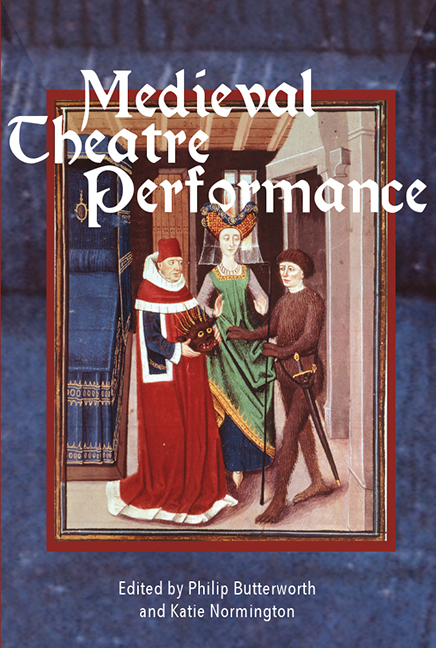Book contents
- Frontmatter
- Dedication
- Contents
- List of Illustrations
- Contributors
- Abbreviations of Principal Sources Cited
- Introduction
- Synopses
- 1 From Archive to Repertoire: The Disguising at Hertford and Performing Practices
- 2 Walk, Talk, Sit, Quit? On What Happens in Netherlandish Rhetoricians’ Plays
- 3 Performing Intrusions: Interaction and Interaxionality in Medieval English Theatre
- 4 Player Transformation: The Role of Clothing and Disguise
- 5 Pavilioned in Splendour: Performing Heaven in Fifteenth-Century Florence
- 6 Living Pictures: Drama without Text, Drama without Action
- 7 Performer-Audience Relationships in Fifteenth- and Sixteenth-century Danced Spectacles
- 8 Decadance in the Late Middle Ages: The Case of Choreomania
- 9 Writing, Telling and Showing Horsemanship in Rhetoricians’ Farce
- 10 Inanimate Performers: The Animation and Interpretive Versatility of the Palmesel
- 11 ‘lyke unto a lyvelye thyng’: The Boxley Rood of Grace and Medieval Performance
- 12 The Mechanycalle ‘Ymage off Seynt Iorge’ at St Botolph's, Billingsgate, 1474
- Bibliography
- Index
8 - Decadance in the Late Middle Ages: The Case of Choreomania
Published online by Cambridge University Press: 21 August 2018
- Frontmatter
- Dedication
- Contents
- List of Illustrations
- Contributors
- Abbreviations of Principal Sources Cited
- Introduction
- Synopses
- 1 From Archive to Repertoire: The Disguising at Hertford and Performing Practices
- 2 Walk, Talk, Sit, Quit? On What Happens in Netherlandish Rhetoricians’ Plays
- 3 Performing Intrusions: Interaction and Interaxionality in Medieval English Theatre
- 4 Player Transformation: The Role of Clothing and Disguise
- 5 Pavilioned in Splendour: Performing Heaven in Fifteenth-Century Florence
- 6 Living Pictures: Drama without Text, Drama without Action
- 7 Performer-Audience Relationships in Fifteenth- and Sixteenth-century Danced Spectacles
- 8 Decadance in the Late Middle Ages: The Case of Choreomania
- 9 Writing, Telling and Showing Horsemanship in Rhetoricians’ Farce
- 10 Inanimate Performers: The Animation and Interpretive Versatility of the Palmesel
- 11 ‘lyke unto a lyvelye thyng’: The Boxley Rood of Grace and Medieval Performance
- 12 The Mechanycalle ‘Ymage off Seynt Iorge’ at St Botolph's, Billingsgate, 1474
- Bibliography
- Index
Summary
In most scholarship, Choreomania conveys a context in which dance is inextricably linked to medicine. Choreomania, or dance mania (from the Greek terms choros, or dance, and mania, or madness), refers to the dance epidemics that swept Europe between the fourteenth and sixteenth centuries. During this time, French, Flemish and German chroniclers reported how hundreds of people erupted in excessive, frenzied movements, sometimes dancing themselves to death. Although once a medieval phenomenon, Choreomania has since become integrated into modern, medicalised understandings of chorea (from the Latin word for dance). Today's medical literature typically defines Choreomania as ‘a hyperkinetic movement disorder characterised by excessive spontaneous movements that are irregularly timed, randomly distributed and abrupt’. The neuropathological (and sometimes psychiatric) reconstitution of Choreomania may acknowledge its medieval predecessors, but tends to divorce this disease from folkloric legends and superstitions.
Choreomania entered western medical discourse as early as the sixteenth century. The Renaissance polymath Paracelsus (born Philippus Aureolus Theophrastus Bombastus von Hohenheim in 1493) rejected the medieval assumption that demonic possession caused dance mania. Instead, he studied the physiological symptoms of choreomaniacs (dance maniacs) and prescribed specific remedies. In the following century, Thomas Sydenham renamed Choreomania as Sydenham's chorea (or chorea minor), a disorder characterised by involuntary and jerky motions. (This diagnosis, however, actually refers to a form of acute rheumatic fever.) Due to overlapping physiological symptoms, Choreomania in the nineteenth century had been associated (erroneously) with Huntington's disease, a neurodegenerative genetic disorder.
In an effort to diagnose medieval choreomaniacs, more recent studies on Choreomania applied modern epidemiology to the extant medieval evidence. In the twentieth century, the Swedish pharmacologist Eugene Louis Backman argued that Choreomania was caused by ergotism, a species of poisoned fungus (claviceps purpurea) that exhibits properties similar to that experienced with Lysergic acid diethylamide (LSD) use. Following the multiple floods that occurred in Flanders and the Rhineland in the Late Middle Ages, Backman suggests that ergot would have infected the grains consumed by medieval subjects, particularly peasants. Backman explains that the ergot in rye induces hallucinations, agitation, intensely colored vision and increased susceptibility to external influences (such as rhythm, which initiates dancing).
- Type
- Chapter
- Information
- Medieval Theatre PerformanceActors, Dancers, Automata and their Audiences, pp. 141 - 160Publisher: Boydell & BrewerPrint publication year: 2017



